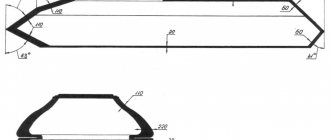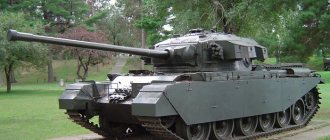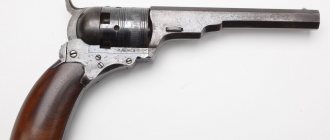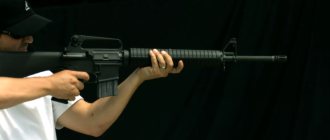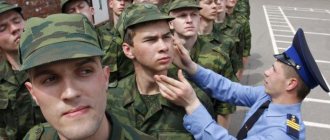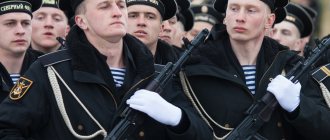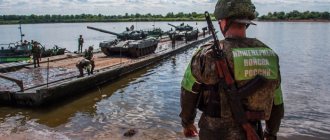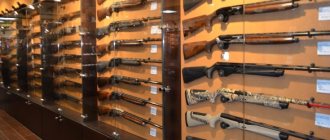If at that time the refusal occurred due to the ruler’s great humanity, then on the eve of the 1917 revolution the emperor refused a new appeal for a different reason. This time, police batons turned out to be inappropriate, since more effective weapons had to be used to pacify the riots. Attempts were repeated several times during the USSR. However, under the totalitarian Stalinist regime there was no such need. Therefore, it was only in 1962 that a resolution was adopted on the wearing of rubber truncheons by police officers.
With the increase in crime, such cases have become more frequent in relation to employees of the police department and the penal system. To resist intruders, employees of security companies, the penitentiary system and the police are equipped with such an effective special tool as a stick.
Where can you hit a security guard with a rubber stick?
Police batons vary in length. There are short batons, the size of which ranges from 20 to 45 centimeters. Short batons are used for special operations when short, sharp blows are needed and are used in special institutions - prisons, colonies.
At the inspector’s command: “Start the exercise!” the person being tested removes the rubber stick from the suspension and strikes the dummy (at least six) in various areas allowed for impact with the rubber stick. After this, the person being tested reports: “The exercise has finished.” Time to complete the exercise: 20 seconds. When performing
229. What is the purpose of the fastener found in the design of handcuff bracelets used in private security activities? 1. Fixing the handcuff key to one of the bracelets (to avoid losing it). 2. Blocking the engagement mechanism of the movable locking arm of the handcuff bracelet. 3. Blocking access to the keyhole of the handcuff bracelet.
I’m a “busy” person, specifically I’m wearing a bag/backpack with quite a lot of weight with a tool, about 20 kg, so running away is not an option, in all skirmishes/confrontations I have to “beat”, during two years of such movements in the city, different things happened, Let’s just say, somewhere the appearance was “pulling out”, somewhere a good slap from the side/blow from the ankle, the knife was pulled out only once, and this was under a direct threat from the “drunken prisoner”, and even in that case the appearance was recoon tanto, which was purchased for conditions of “hard work,” stopped the attacker; in other cases, it was enough to pay attention to the “folder” that “always hangs on your pocket.” In cases of a serious attack, which, fortunately, I have not had, I consider it necessary to use a knife only in cases where the attacker has a weapon, and in no case should you hit the carcass; a wound to the limb will be enough and the attacker will quickly cool down in the desire to “squeeze” something. It is advisable to have a minimum set of “first aid kit” with you, I always have bandages, peroxide, instead of a tourniquet there is paracord, there are also small things like brilliant green, painkillers. But these are my personal observations and the situations I found myself in.
The handle can be metallized (in a reinforced version) and has notches. This type of baton was initially used only by riot police, but currently most police officers are equipped with them. Also purchased by citizens for self-defense or for training in hand-to-hand combat.
In the Soviet Union, the use of batons until the 50s was based on English experience and old-style police batons were used. In the 70s, a police rubber baton, models PR-73 and PR-73F, made of elastic material, was introduced into circulation.
However, the specifics of its use require knowledge of some subtleties that will allow you to make the most of the capabilities of this means of self-defense. Contents The following factors when striking directly depend on how correctly you hold the baton in your hand:
In general, management doesn’t like this. It’s better to stick such things deeper in your pockets. No matter what they see. quote: Originally posted by Kuzicheff: This is the question I had: For example, a security guard in a supermarket was attacked and used personal means of self-defense - “Strike”, electric shock or gas spray.
In the USSR, the question of arming the police with rubber truncheons was raised more than once, but only in July 1962, in accordance with the order of the Minister of Internal Affairs of the RSFSR “On the adoption of rubber truncheons and handcuffs by the police,” they came into service. In 1966, the order of the Minister of Public Order of the RSFSR established the procedure for their wearing and use: “It is allowed to carry a rubber stick naked in the hand, as well as on a belt on the left side... Rubber sticks should be introduced only with the permission of the Ministry of Defense of the RSFSR at the request of the ministers of the PLO of the autonomous republics , heads of departments of the PLO regional executive committees, agreed with the relevant regional committees, regional party committees.” It was recommended to resort to its help to “suppress the violence and disorder of hooligans and other criminals, as well as in relation to violators of public order who refuse to comply with the legal demands of police officers, to repel attacks on police officers or vigilantes, officials, state, public organizations and citizens” . However, it was strictly forbidden to strike the face and head and use batons against women, children, the elderly and disabled, as well as in police premises.
Russian legislation contains a rule on acceptable self-defense, including the use of special means, which include a baton. The legislator regulates the limit of self-defense, limiting the actions of the defending citizen to the degree of threat from the attacker.
Technique for using a rubber stick (PR-73), page 2
The special tool PR-73 and its modifications can significantly increase the efficiency of the actions of police officers and the penitentiary system, especially in cases where the use of firearms is extremely undesirable. The rubber stick is an intermediate link between fighting techniques and firearms, as a last resort for suppressing crime.
Correct and skillful use of the PR-73 allows employees to reliably defend themselves and perform techniques that force the criminal to comply with their demands under the threat of force, and not the threat of death. And this is very important, since in most cases the police officer uses weapons because he does not know other options for resolving the incident.
The increase in crime in the country has led to an increase in the number of attacks on police officers while on duty. Often, police officers cannot resist criminals and do not even know how to use special equipment. The same problem exists for employees of the penitentiary system, who, due to the nature of their official activities, have to deal with a diverse contingent of convicts, whose actions are sometimes difficult to predict.
The special rubber stick PR-73 is designed to repel attacks by offenders or suppress their disobedience. Stick weight – 0.73 kg, length – 65 cm, diameter – 32 mm. It has a comfortable rigid handle (holder), which at its base has a durable leather loop, as well as a flexible striking element. The presence of a rubber flexible striking element during the swing gives additional acceleration to the end of the stick in the last phase of the strike, which is an order of magnitude greater than the similar action when striking with a regular stick. The opportunity to gain in speed gives a significant gain in strength. And the presence of a leather loop allows you to fix and relax the hand when gripping a stick, which increases freedom of movement during striking and defensive actions and prevents loss of the stick.
The use of special means in institutions of the penal system is regulated by the Law of the Russian Federation “On Institutions and Bodies Executing Criminal Punishments in the Form of Imprisonment” and Order of the Ministry of Internal Affairs of the Russian Federation No. 453 of 1996. In the system of the Ministry of Internal Affairs, the use of special means is regulated by the Law of the Russian Federation “On Police” and the order No. 127 of 1989
The use of special means must be preceded by a warning about the intention to use them and sufficient time provided to comply with the requirements of the private security guard, except in cases where delay in using handcuffs creates an immediate danger to their life and health or may entail other serious consequences.
A rubber stick is a special tool designed for active defense, used in private security activities, and is included in the list of types of weapons of private security guards when repelling an attack that directly threatens the life and health of a security guard and (or) to suppress a criminal encroachment on protected property when the offender physical resistance.
The right to use special means during the performance of professional duties is granted to private security guards who have undergone appropriate training and passed an examination at the Department of Internal Affairs for professional suitability to act in situations related to their use, having an identity card of a private security guard and a qualification rank. Today in Russia there are officially three categories of security guards - 4, 5 and 6. Security guards of the 4th category are allowed to perform their duties only with a rubber truncheon and handcuffs. Security guards of the 5th category, in addition, have the right to use gas canisters and stun guns. Security guards of the 6th category have the right to use all of the above means plus service firearms. Frequency of confirmation of a security guard's rank: 4.5 rank - once every 2 years, 6th rank - every year.
The Tsar refused the minister's request, but the question of the need for a club was raised many times until 1917. When analyzing archival data, it turned out that at the end of the 19th - beginning of the 20th century in Russia, first wooden clubs were offered for arming the lower ranks of the city police, and then “stacks”, similar in purpose and methods of use to those fashionable in the allied countries (France and England) police batons. However, in Russia, these innovations did not take root at that time - in order to pacify the growing rebellious masses, armed with bladed weapons and firearms, different weapons were required for policemen.
A rubber stick is designed to strike the body of an offender in order to repel an attack or suppress the disobedience of an offender located at a distance of no more than 1.5 m. With its help, you can defend yourself from an armed attack, detain the offender, and deliver him to the police department. You cannot strike on the head, neck and clavicular area, stomach, genitals, in the area of the projection of the heart, and also strike repeatedly in the same place. Illegal use of special means entails liability established by law.
The person being tested is 1.5 meters opposite the dummy. The rubber stick is suspended on a belt. At the inspector’s command: “Start the exercise!” the person being tested removes the rubber stick from the suspension and strikes the dummy (at least six) in various areas allowed for impact with the rubber stick. After this, the person being tested reports: “I have finished the exercise.” Exercise time: 20 seconds. When performing the exercise, blows must be applied in a fixed manner, without using excessive force that could damage the dummy. Positive result: performing at least six blows with a rubber stick on a dummy within the specified time, without allowing blows to areas corresponding to areas of the human body that are not allowed to be impacted.
Appendix No. 2 to the Regulations on the conduct of periodic inspections by the internal affairs bodies of the Russian Federation of private security guards and employees of legal entities with special statutory tasks for suitability for action in conditions associated with the use of firearms and special means
Testing a security guard for knowledge and use of special equipment is one component of the periodic inspection of a security guard. Although many will say at first glance that it is not so difficult, but judging by surveys, 85% of security guards who could not pass the test the first time “fail” on this test. Why is this happening? The reason is very simple. When you answer the theoretical tickets of the qualifying exam here, everything is simple, you just need to know the correct answer. In testing for knowledge and use of special equipment, tickets are also used, but you have to answer practically and here the “marketing frequency” of the inspectors is turned on, who often each have their own interpretation of the correct execution of a practical question, which often differs from the interpretation of execution set out in the orders of the Ministry of Internal Affairs. Another reason is the guard’s lack of knowledge of special equipment, who cannot, for example, distinguish a PR-K from a PR-73M. Let's consider these questions in more detail:
STANDARD EXERCISES FOR THE PRACTICAL APPLICATION OF SPECIAL TOOLS, THE IMPLEMENTATION OF WHICH IS PROVIDED FOR PRIVATE GUARDS 4, 5, 6 CLASSES AND EMPLOYEES OF LEGAL ENTITIES WITH SPECIAL STATUTORY TASKS WHEN PASSING PERIODIC APPLICABILITY TESTS TO ACTIONS IN CONDITIONS RELATED TO THE USE OF SPECIAL MEANS
The person being tested is 1.5 meters opposite the dummy. The handcuffs are on the belt in a case. At the inspector’s command: “Put handcuffs in front (or behind)!” the person being checked takes the handcuffs out of the case, approaches the dummy, puts on the handcuffs and fixes their bracelets. After that he reports: “The handcuffs are on.” Exercise time: 25 seconds. When put on, the handcuffs should rotate freely and securely fix the limb. After checking the correctness of putting on the handcuffs, at the inspector’s command: “Remove the handcuffs!”, the person being inspected removes the handcuffs. Positive result: handcuffs were correctly applied within the specified time and then removed.
The complex criminal situation essentially forces employees of non-state security agencies to effectively use various special means for self-defense. It is they, in combination with service weapons and special training, that are one of the important ways to increase the combat readiness and protection of private security personnel from the threat of the use of physical force, bladed weapons and firearms from criminals and lawbreakers.
If at that time the refusal occurred due to the ruler’s great humanity, then on the eve of the 1917 revolution the emperor refused a new appeal for a different reason. This time, police batons turned out to be inappropriate, since more effective weapons had to be used to pacify the riots. Attempts were repeated several times during the USSR. However, under the totalitarian Stalinist regime there was no such need. Therefore, it was only in 1962 that a resolution was adopted on the wearing of rubber truncheons by police officers.
- The accessory serves well for self-defense. It is advisable to direct the blows (with a pull) to where the skin is exposed. This makes it more painful.
- Law enforcement officers quite often show interest in baton owners. The outcome may vary. Permission may be required.
Carrying a long baton with you is not very convenient, but in a car it can be very useful.
Finally, law enforcement agencies of a number of Western states and countries are armed with special equipment in the form of police batons, which, when the trigger button is pressed, “shoot” a charge of irritant[1]. There are also models of batons with a built-in stun gun[2].
For security guards of private services, such permission was given in 1992. For more than a quarter of a century, legislation in this area has changed significantly. At the same time, the main one here was and remains the Federal Law “On private detective and security activities in the Russian Federation” with numerous amendments. This document regulates the use of rubber batons, and also determines the types of this special equipment permitted for use by private security guards.
How to use a baton for self-defense
Strikes with a telescopic (like model 21 from ESP and even homemade devices), bat (like Polis 30000 and B-95) and simply a rubber baton (eg PG-M, RDU-50, PR-73M and Tonfa) on different parts of the body have various consequences. And although the baton is not a lethal weapon for self-defense, blows from it are quite sensitive and can even cause significant injuries.
Read more: How to get maternity capital for your third child
Different parts of the body have different degrees of sensitivity, and therefore blows to them differ in their effectiveness. For example, many people probably believe that a blow to the head will definitely neutralize the enemy. However, in practice it often turns out that this does not happen with a blow to the head: a slight stun, even if it occurs with a very strong swing, passes relatively quickly and does not significantly complicate a further attack.
Since the main danger is concentrated in the enemy’s hands (with them he can grab, hold, choke, and also hold a weapon), it is recommended to strike at them first. As noted above, strikes should be started first on the areas of the hands, which are located further from the body and closer to the one who is defending himself with the baton. These are the hands, which also contain the means of attack. In addition, the hands are made up of small bones that are highly sensitive to blows, and damage to them makes it possible to stop an attack more quickly.
After the hands, you should focus your attention on the forearms. Here, too, the bones are not too thick, the muscles are sensitive to mechanical stress. With a good blow to the forearm, a sharp pain occurs, which will interfere with the enemy’s further actions and force him to drop the weapon from his hands.
Legs are also important when attacking, because with their help the enemy moves and can change his position so quickly that it becomes difficult to reach and neutralize him. First of all, blows with a baton are applied to the shin: the bones here are thin, the muscles are especially sensitive to blows. And an injured leg will no longer allow you to move quickly.
The hips are less sensitive to impacts, but when delivering them it is recommended to use the maximum swing. Oblique blows are especially sensitive to this area; a series of short slashing actions will quickly neutralize the enemy and limit his ability to move.
Head
Blows to the head can vary significantly, and although most of them are not lethal, this type of impact should still be carried out as carefully as possible, because the purpose of using a baton is to stop the attack and repel it, and not to criminalize the infliction of serious injury or death of a person.
Blows to the eyes and temple area are very noticeable and especially dangerous, therefore it is not recommended to direct blows of the baton to these areas. The occipital and frontal bones of the skull are the strongest, therefore, to lose the enemy’s orientation, it will be enough to hit him on the head in these parts.
Several blows delivered in a series allow for maximum effect, and blows to the head are among the most effective when used in sharp and slashing movements. Moreover, if you deliver several strikes in one place, the result of neutralizing the enemy will not be long in coming: he will not be able to navigate in space and will allow you to stop his actions.
How to properly use a rubber stick for a security guard
3. Special means are used by private detectives and security guards in cases where non-violent methods of preventive influence on offenders are used and do not produce the desired results: a) to repel an attack that directly threatens their life and health; 4. Special means in accordance with paragraph 3 of these Rules may be used:
At the command of the manager, the worker being inspected puts a protective helmet of the specified class on the dummy and reports: “The protective helmet of class 1 (or 3) is on.” The exercise time is 20 seconds. Often, those who are called upon to maintain order themselves become the target of attack.
- When performing exercise 1, a protective helmet is worn only if sanitary and hygienic standards are observed (use of the personal headgear of the employee being inspected, napkins, liners, etc.).
- Exercises 3 and 4 are performed on a mannequin.
- Requirements for the mannequin:
- the mannequin must follow the contours of the human body;
- head and limbs are required;
- The upper limbs should imitate the structure of the hand and have 3 degrees of freedom to ensure the exercise is performed.
- As an exception, exercises 3 and 4 can be performed with a partner, strictly with his written consent. At the same time, when performing exercise 3, your partner must wear a protective vest.
- When performing exercise 3, blows must be applied firmly, but without using excessive force that could damage the dummy or injure a partner.
- Exercise 4 is considered completed correctly if, when worn, the handcuffs rotate freely and at the same time securely fix the limb.
Depending on the model of the baton, its design, material, weight, length and thickness may vary. Previously, police batons were made from durable wood, but now they are most often made from rubber and polypropylene (a polymer synthetic material), less often from plastic, and even less often from metal.
In addition, defense can be used by repelling - a pushing blow with the middle part of the stick while grabbing the ends with both hands. With this grip, the inertial properties of the stick become insignificant, since the mass is divided into two hands, and the elastic properties are not a hindrance. Hitting with a push blow with a rubber stick has an advantage over beating with, for example, the forearm.
The employee being checked is located near the table with protection helmets of 1 and 3 classes. At the command of the manager, the worker being inspected puts a protective helmet of the specified class on the dummy and reports: “The protective helmet of class 1 (or 3) is on.” The exercise time is 20 seconds.
The person being tested is 1.5 meters opposite the dummy. The rubber stick is suspended on a belt. At the inspector’s command: “Start the exercise!” the person being tested removes the rubber stick from the suspension and strikes the dummy (at least six) in various areas allowed for impact with the rubber stick. After this, the person being tested reports: “I have finished the exercise.”
The rules for the use of special means by private security guards, established by Decree of the Government of the Russian Federation No. 587 of August 14, 1992, are essentially additional requirements for the use of special means to those requirements contained in Articles 16 and 17 of the Law “On Private Detective and Security Activities” .
Ensuring individual protection of the human head from weapons of destruction (bullets, shrapnel, bladed weapons) and contusions due to impacts.2. Ensuring individual protection of a person’s head from weapons of destruction (bullets, shrapnel, bladed weapons) and the delivery of defensive blows to the offender.1 203.
Which type of firing should the guard choose? What concept is defined as “a set of jointly operating technical means that make it possible to automatically or manually issue alarm signals to the monitoring station (to the duty station) in the event of a robbery attack on an object during its operation”?
(It is prohibited to use special means against women with visible signs of pregnancy, persons with obvious signs of disability and minors, when their age is obvious or known to a private detective (security guard), except in cases of armed resistance, a group or other attack that threatens life and health private detective (security guard) or protected property.
Appendix No. 2 to the Regulations on the conduct of periodic inspections by internal affairs bodies of the Russian Federation of private security guards and employees of legal entities with special statutory tasks for suitability to act in conditions associated with the use of firearms
In Russia, the legal aspect of the acquisition of a rubber police baton by citizens is not regulated by law. The RDU 50 baton has been certified and can be sold and carried freely as a self-defense weapon (Certificate of Conformity POCC RU. СЗ09.
On May 20, 1881, the Minister of Internal Affairs of the Russian Empire sent a report to the emperor with a request to arm the lower ranks of the St. Petersburg police with “wooden clubs” instead of dragoon-type checkers. Despite the emperor’s refusal, police “wooden clubs” that had already been made earlier were issued to some police officers.
Appendix No. 2 to the Regulations on the conduct of periodic inspections by internal affairs bodies of the Russian Federation of private security guards and employees of legal entities with special statutory tasks for suitability to act in conditions associated with the use of firearms
Security guard test
31.10.2009 1.
Which organs (parts of the body) are allowed to be struck with a rubber stick? 1).
On the head2). By limbs3).
Along the neck4). By the genitals2) 2. From what distance can a shot from a gas pistol at a person be dangerous to his health?1). Up to 2 meters2). Up to 3 meters3). Up to 1 meter4). 1.5 meters3) 3. How to provide first aid for a bruised soft tissue of the thigh?1). Place a tight bandage and an ice pack on the site of the injury for 15-20 minutes.2).
Give the limbs an elevated position, rest 3).
Bandage the entire limb tightly (from bottom to top), apply a splint, as if for a fracture. Inside with 1/2 teaspoon of baking soda, drink plenty of fluids4).
Place your leg on a soft bundle of clothing, apply ice and cold lotions to the damaged one1) 4. How to provide first aid for a fracture of the pelvic bones?1).
Apply a tight bandage to the injury site and place the victim in a semi-sitting position2). Lay the victim on his back on a hard surface, apply a hot heating pad to the injured areas3).
Place the victim on a hard, flat, hard surface, and place a bolster under the bent and spread knee joints3) 5. How to transport a victim with a closed abdominal injury?1). Lying on your side or back with a hot heating pad at the site of the injury2).
In a supine position with cold at the site of the bruise (ice, lotion) 3). In a lying, half-sitting position, the knees are as close to the body as possible2) 6. What first aid should be provided if the victim has a fractured collarbone?1).
We recommend reading: Study of the economic state of the enterprise conclusion
Apply a cold compress to the fracture site and bandage tightly 2). Apply a splint to the axillary area and bandage the straightened arm to the body3). Place a roll of cotton wool or a bandage in the axillary area and bandage the arm bent at the elbow to the body3) 7.
How to transport a victim with damage to the thoracic spine? 1). Lying on your back on a hard board2). Lying on your back on a soft mat3).
Lying on your side on a hard board1) 8. What type of transport should you use to transport a victim with a moderate traumatic brain injury?1). By passing passenger car2).
By passing truck3). Only by ambulance3) 9.
Which material is best suited for use as an immobilizing splint for bone fracture?1). Bandage2). Fabric3). A piece of board3) 10. What is the 5% iodine solution included in the first aid kit used for?1).
For treating the skin around the wound2).
To lubricate the entire surface of the wound when the wound is heavily contaminated 3). For lubricating the skin in case of first degree chemical burns1) 11.
How to perform chest compressions and artificial respiration if resuscitation is carried out by 2 people at the same time? 1).
Press on the chest once, blow air once, etc. 2). Blow air once, then press on the heart area 5 times, etc. 3). After 2-3 breaths of air, press on the chest 15 times2) 12.
In what sequence is it necessary to provide first aid to a victim when his cardiac activity and breathing stop? 1).
Perform a heart massage, open the airways, perform artificial respiration2).
Do I need to wear handcuffs when taking the 2022 exam?
In modern security practice, handcuffs are commonly referred to as various models of passive special equipment designed to restrict the freedom of action of a detainee or a group of detainees. Today, the use of such means in our country is regulated by the Federal Law “On Private Detective and Security Activities in the Russian Federation.” This law defines the basic rights and responsibilities of private security guards for the use of this category of special security equipment. Employees of CHOP LEGIS legally use handcuffs in their practice when providing various types of security services in Moscow, St. Petersburg, Krasnodar and other populated areas. In this article you will find a detailed description of the design of handcuffs and their classification. The key features of the use of such special security equipment, as well as the basic requirements for their operation, are highlighted here. The review also identifies rules governing the use of handcuffs by private security guards. HOW HANDCUFFS ARE CONSTRUCTED: GENERAL DESCRIPTION AND PURPOSE OF APPLICATION
PR) and handcuffs (BRS-2, BRS-3, etc.) for better performance of service at guarded facilities and the greatest safety of their employees. For this purpose, 4th category security guards are sent for training and then to pass an exam at USC STRELOC LLC to obtain the right to wear and use special equipment during duty hours.
Testing a security guard for knowledge and use of special equipment is one component of the periodic inspection of a security guard. Although many will say at first glance that it is not so difficult, but judging by surveys, 85% of security guards who could not pass the test the first time “fail” on this test. Why is this happening? The reason is very simple. When you answer the theoretical tickets of the qualifying exam here, everything is simple, you just need to know the correct answer. In testing for knowledge and use of special equipment, tickets are also used, but you have to answer practically and here the “marketing frequency” of the inspectors is turned on, who often each have their own interpretation of the correct execution of a practical question, which often differs from the interpretation of execution set out in the orders of the Ministry of Internal Affairs. Another reason is the guard’s lack of knowledge of special equipment, who cannot, for example, distinguish a PR-K from a PR-73M. Let's consider these questions in more detail:
The worker being tested is 1.5 meters opposite the dummy. The handcuffs are on the belt in a case. At the command of the manager, “Place handcuffs in front (or behind),” the employee being inspected takes the handcuffs out of the case, approaches the dummy and warns of his intention to use them: “Stop, I’ll use special equipment.” Puts handcuffs on depending on the task assigned by the leader (front or back). After that he reports: “The handcuffs are on.”
Testing a security guard for knowledge and use of special equipment is one component of the periodic inspection of a security guard. Why is this happening? The reason is very simple. When you answer the theoretical tickets of the qualifying exam here, everything is simple, you just need to know the correct answer. In testing for knowledge and use of special equipment, tickets are also used, but you have to answer practically and here the “marketing frequency” of the inspectors is turned on, who often each have their own interpretation of the correct execution of a practical question, which often differs from the interpretation of execution set out in the orders of the Ministry of Internal Affairs. Let's consider these questions in more detail:. N
Exam. Practical exercises.
Powerful civilian stun guns.
What first aid should be provided if the victim has a fractured collarbone?1). Apply a cold compress to the fracture site and bandage tightly 2).
No permit or license required. Complies with the Weapons Law. March 30, 2007 The person being checked selects a ticket with the exercise number. Completing this exercise counts as successfully passing the test of practical skills in using special equipment. Exercise 1. “Using a protective helmet” The person being tested is located near a table with protective helmets of class 1 and 3.
At the command of the supervisor, “Put on a protective helmet of 1 (or 3) class,” the person being tested puts on a protective helmet of the specified class and reports: “I have finished the exercise.”
The exercise time is 20 seconds. Positive result: A protective helmet of the appropriate class is worn and fastened within the specified time. Exercise 2. “Using a protective vest” The employee being inspected is located near a table with protective vests of grades 1 and 5.
At the command of the manager, “Put on a protective vest of class 1 (or 5),” the inspected employee puts on a protective vest of the specified class and reports: “I have finished the exercise.” The exercise time is 20 seconds. Positive result: The protective vest of the appropriate class is correctly worn and fastened within the specified time.
We recommend reading: Is it possible to return clothes if you cut off the label and the clothes are defective?
Exercise 3. “Using a rubber stick” The person being tested is 1.5 meters opposite the dummy. The rubber stick is on the belt (in the PR suspension). At the command of the supervisor, “Start the exercise,” the person being tested takes the rubber stick out of the suspension and warns of his intention to use it: “Stop, I’ll use special equipment.”

